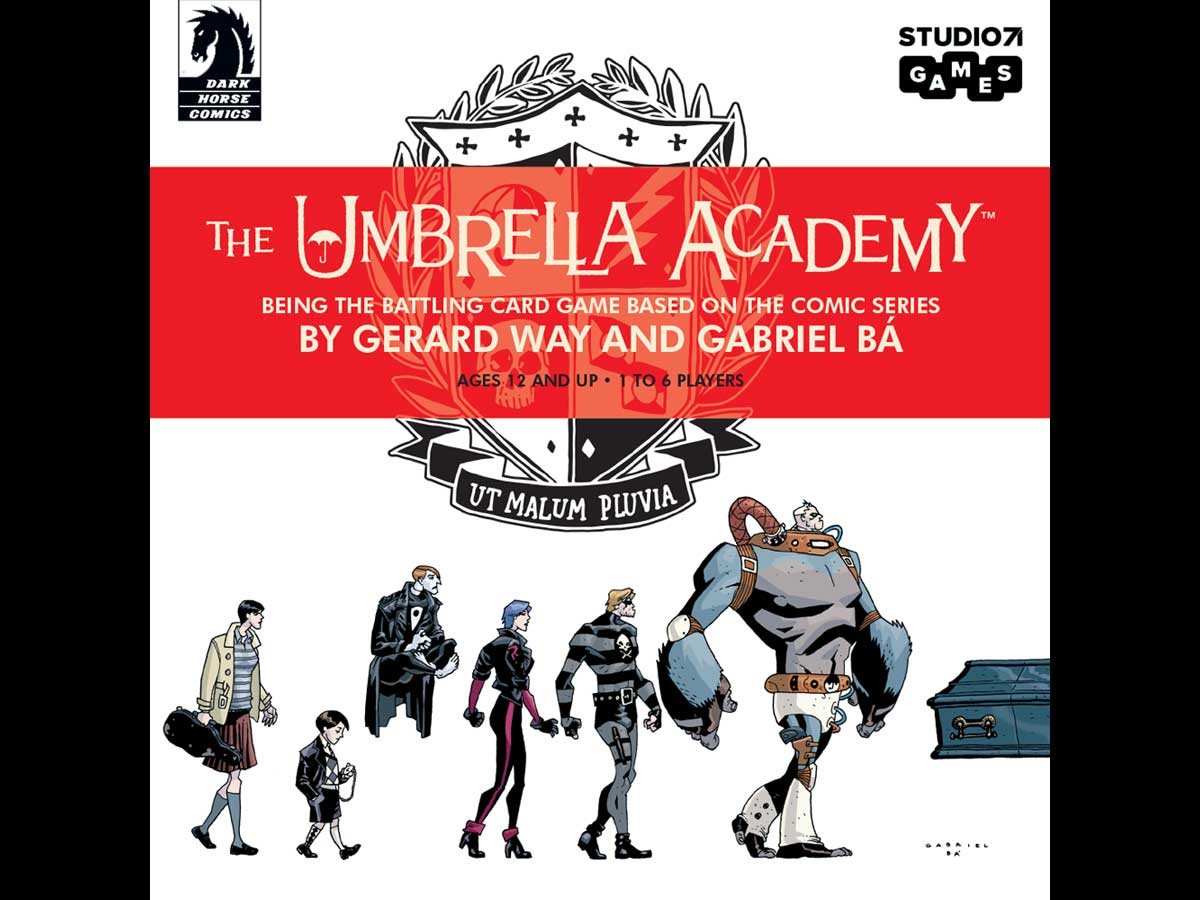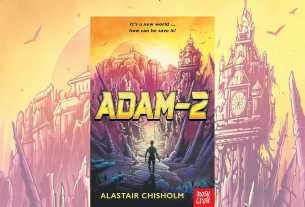Seven siblings, born under mysterious circumstances, were adopted by billionaire Sir Reginald Hargreeves, who honed their strange abilities and created the Umbrella Academy. Unfortunately, the family fell apart when they became teenagers … but now it’s time to save the world.
What Is The Umbrella Academy Card Game?
The Umbrella Academy Card Game is a cooperative card game for 2 to 6 players, ages 12 and up, and takes about 20 minutes to play. It’s currently seeking funding on Kickstarter, with a pledge level of $25 for a copy of the game. (There are also higher pledge tiers for the deluxe edition and the collector’s edition.) I’ll note that the “20 minute” game length is what’s cited on the Kickstarter page, but that seems significantly shorter than I’d expect, especially with more players, so I would probably say 40 to 60 minutes instead except for a 2-player session.
The Umbrella Academy Card Game is based on the comic book by Gerard Way and Gabriel Bá, and features illustrations from the comics. Although knowledge of the comics or show isn’t needed to play the game, it does provide at least a little more context to the story behind it. The game is designed by Scott Dean and published by Studio71.
New to Kickstarter? Check out our crowdfunding primer.

The Umbrella Academy Card Game Components
Note: My review is based on a prototype copy, so it is subject to change and may not reflect final component quality.
Here’s what comes in the game:
- 89 Hero Attack cards
- 7 Player cards
- 7 Life cards
- 32 Villain Attack cards
- Start Player card
- 26 Dysfunctional Family cards
- 36 Villain cards
- Final Battle card
The deluxe edition will also include a game board that helps indicate where the various decks are placed, but it’s not really necessary to play the game.

All of the cards feature artwork from the comic book, and many of the cards use a single color, making the game visually striking and colorful. For the most part, there isn’t a lot of text on the cards aside from a few special abilities, which also helps to showcase the artwork. Some of the dysfunctional family cards and the villain cards have comic panels instead of character close-ups, so there are snippets of dialogue; they won’t make much sense if you haven’t read the books, but they do provide a bit of flavor and demonstrate this bizarre world.

The villain cards (seen above) have villain attacks on their backs, which can be a little confusing because they can seem similar to the villain attack cards, though the attack values are higher. It might have been nice to have some other sort of distinguishing feature so that they don’t get mixed up.
In the basic edition, the game is entirely cards. Hopefully the quality of the cards will be nice, since the hero attack deck is really big and will need some thorough shuffling.
How to Play The Umbrella Academy Card Game
You can download a copy of the rulebook here.
The Goal
The goal of the game is to survive a series of villain battles, including the final battle.

Setup
Each player takes a character card and a life card, setting them up so that the 5 life bars are showing. (As you take damage, you’ll slide your character card down, covering up life bars.) Shuffle the hero attack deck and deal 5 cards to each player (or 7 in a 2-player game).
Shuffle the villain cards—those are the horizontal ones with villain names and a row of card icons—and make a stack of 5, 7, or 10 depending on player count. Put the rest of the villains away. Shuffle the villain attack deck and the dysfunctional family deck set them nearby. Choose a start player and give them the start player card.
Gameplay
Each round, you’ll set up the next villain battle, draw a dysfunctional family card, and then fight the villains—first with your hero attack cards, then with your character abilities. If you survive the fight, then you move to the next villain.
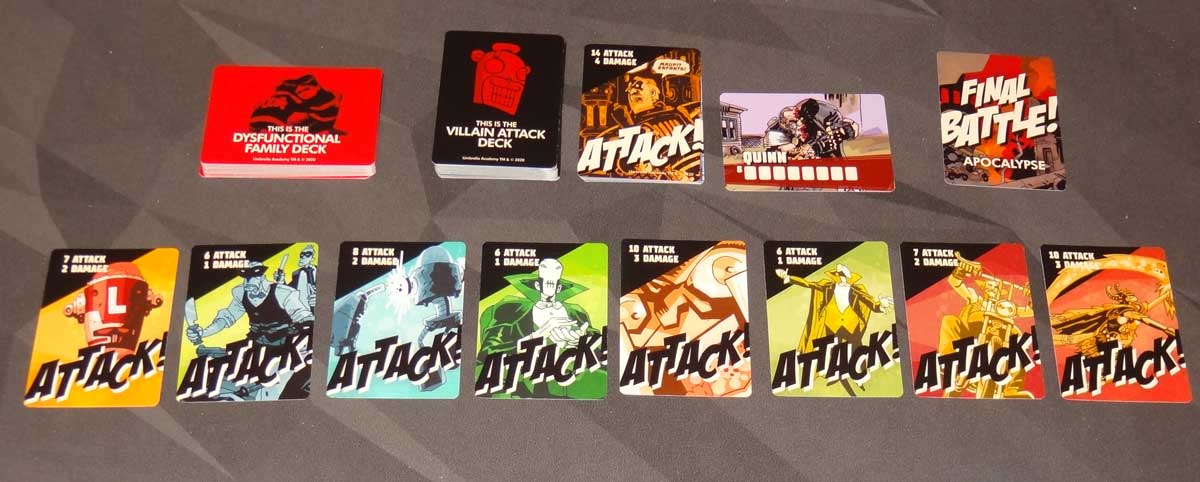
Reveal the next villain from the stack. Each villain has a number and icons below its name, indicating how many villain attack cards you must draw and place in a row.
 Dysfunctional family cards have negative effects each round. (Prototype shown) Photo: Jonathan H. Liu
Dysfunctional family cards have negative effects each round. (Prototype shown) Photo: Jonathan H. Liu
Next, you draw a card from the dysfunctional family deck. These have negative effects, like losing life, adding extra villains, or negating special powers. There’s even one card, Family Secrets, that penalizes players for talking for that round.
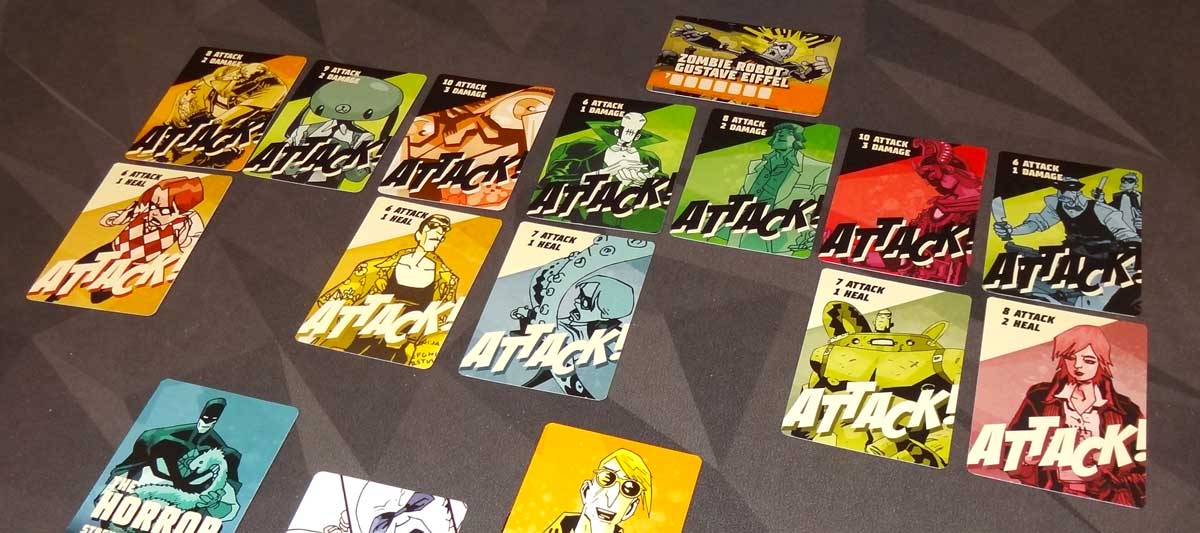
Finally, it’s time to fight. Players take turns playing one card each below the villain attack cards, from left to right. You may play your card either as an attack, or to heal yourself (if there’s a heal value on it), or as a story card (if it has a special effect). If you play a card to heal or for its story effect, it gets discarded, and you skip over that villain attack card, leaving the space below it empty. Hero attacks must exceed the villain attack to be successful.

Once you’ve reached the end of the villain line, each player may use their special ability once, at a cost of 1 life.
- Vanya: Remove 4 villain attack cards, but deal 2 damage to 1 player. (Note that Vanya’s power takes a round to recharge after use.)
- The Kraken: Play a second card against a villain attack (and add the attack values).
- The Horror: Add 2 life to the players, distributed however you like.
- The Rumor: Remove 1 villain attack.
- Space Boy: Double the attack value of one card.
- Number Five: Move any 2 attack cards.
- Seance: Take one of the top 3 cards from the discard pile and play it.
 Villain attack cards also range from 5 to 10. (Prototype shown) Photo: Jonathan H. Liu
Villain attack cards also range from 5 to 10. (Prototype shown) Photo: Jonathan H. Liu
Now, compare the hero attacks to the villain attacks. Discard the pairs where the heroes succeeded. Then, add up the damage values on the remaining villain attacks. The players must distribute that much damage among themselves. If you run out of life, you’re dead and you’re out of the game, though of course you may still continue to discuss strategy and advise your surviving siblings. The villain attack cards are now discarded, and the villain card is placed underneath the final battle card.
If at least one player survived the fight, the game continues. Players draw back up to a hand of 5 cards each, and a new round begins with the next villain in the stack.
If you reach the end of the villain stack, then it’s time for the final battle! Take the villain cards from below the final battle card, shuffle them, and place them in a lineup. You’ll notice that their attack values and damage values are much higher than the regular villain attack cards.

Play the final battle just like the previous fights.
Game End
If all of the players run out of life, you lose the game.
If any players survive the final battle, then you win.
Why You Should Play The Umbrella Academy Card Game
I’ve read a little of The Umbrella Academy comic book, but it’s been a while. Mostly what I remember of it is the striking art style and the very weird world, right from the premise: that these babies were all born on the same day to women who hadn’t been pregnant the day before, and that Hargreeves only managed to adopt seven of them. It reminds me, both in the way it looks and strangeness of the world, a little bit of Hellboy (which I also enjoy). Like many, I watched the Netflix series when it was released last year, though I haven’t watched the second season yet. It’s a world that is rich with possibilities, and I was definitely intrigued to see what sort of a game this would be.
I like the idea of a cooperative card game where the players—because of their various family dysfunctions—have trouble working together. That definitely seems in line with the story. If you’re only familiar with The Umbrella Academy through the television series, there will be a whole lot of villains in the game that you don’t recognize, but that’s not really a barrier. You don’t really need to know who the Peppermint Scarves or Zombie Robot Gustave Eiffel are to delight in their wonderful names. Whether you know how the Lincoln Monument came to life, you can easily imagine that he’s still a formidable opponent.
But the other reason you don’t really need to know the story well to play the game is that, alas, all of the villains are basically the same: despite their colorful appearances and names, the only difference between the villains in the card game is the number of attack cards they’ll throw at you. They don’t have any special abilities to help immerse you in the theme or to distinguish themselves from each other. The Umbrella Academy may be a fantastic world to visit, but you’ll only get your foot inside the door.

The places where you’ll get a taste of the theme are in the dysfunctional family cards, the story cards, and the player powers, primarily in the last one. What you’ll discover is that although there’s a whole deck of family dysfunction cards, there are really only a few different effects that are repeated with minor variations. “Dad Hid His Feelings” reduces all hero attacks by 1, but so do “Desperation” and “I Need Some Space.” The story cards are similar: “Ben’s Return” restores somebody to full life, as do Pogo, the Televator, and the Academy’s Destruction, among others.
The player powers are the ones that feel a bit more tied to the actual theme, because they seem like the character powers. Number Five can time travel, swapping two attacks before they hit. Space Boy is powerful and can double a hit. Vanya is extremely powerful and can wipe out four villains, but hurts her own teammates in the process. Like the siblings in the show, the powers don’t seem evenly matched, either. The Horror can distribute 2 points of life to the team—but since it costs 1 life to use an ability, that’s basically a net 1 health gain for the team, whereas eliminating four villains could save the team as much as 12 damage.
The Umbrella Academy Card Game is a fairly simple game as far as the rules go: you line up villain attacks, play through the lineup in turn order, and the resolve the attacks. Rinse, repeat. Although there are some choices to be made, like whether to play an attack card for its power or to heal, there are a lot of things you can’t change. For instance, the fact that you play against the villains from left to right, one time through, means that random chance has a large bearing on whether you can defeat the villains or not. If one player has a lot of high attack cards but their turns line up with the weaker villains, there aren’t a lot of ways to shift things around.
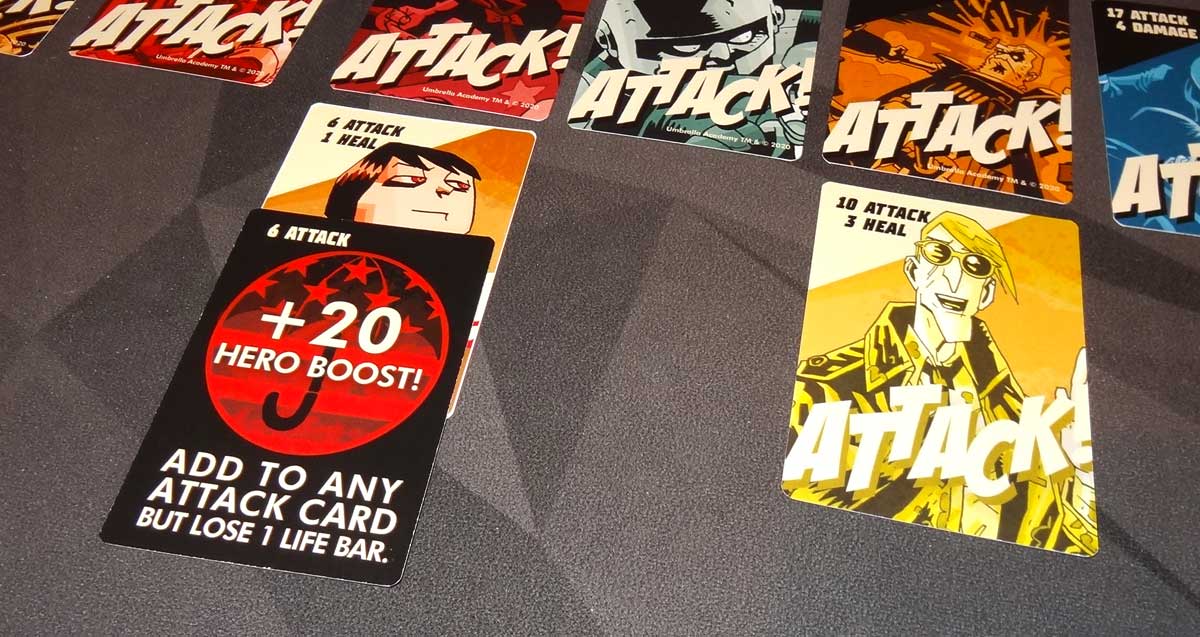
One strange consequence of the way damage is handled in the game is that, unlike many cooperative games, it may not make sense to distribute damage among all of the players. There are quite a few of the “restore a hero to full health” cards, so if you use those and the life boost cards to increase a player’s maximum health, it usually makes more sense to have one player soak all of the damage until they’re almost dead (don’t forget that some of the dysfunctional family cards can make you lose life!), and then just restore all of the damage with a story card in the next round.
Thematically, I suppose it makes sense that you can win the game if at least one player survives the final battle: yes, you lost some teammates, but you saved the world. That seems unconventional for a cooperative game, though, and makes it significantly easier. The attack values in the final battle are extremely high—you won’t be able to beat any of them without using story cards or hero abilities, and you only have so many of those. Hopefully you’ve rationed your cards a bit so that you can save some for the final battle. But even if you can beat one or two of the cards, chances are if you’ve built up life boosts, you may have enough life to just absorb all of the damage anyway. That makes the final battle anticlimactic: if you know that you’re going to win even if you play nothing for the last round, it doesn’t make for a great triumph.
One thing I noticed is that the villains with smaller attack lineups have lower attack values on the back. So your stack of villains will either lead to easier battles and an easier final battle, or harder battles and a harder final battle, simply based on a random draw. I feel like it would make for a more balanced experience if the smaller attack lineups then had higher attack values on the back.
The game is designed for 2 to 6 players—it’s sad that a game about 7 siblings maxes out at 6 players, but I don’t know that I would recommend playing with more than 4 players. Increasing the player count just adds more villains to the stack, which lengthens the game. The essentially identical villains already make the game feel a bit repetitive, so adding a couple more battles feels like the wrong way to go. Instead of a game where you feel like you’re going through increasingly harder levels to reach a boss fight, it kind of feels like playing the same level several times in a row.
I really wanted to like the game—I think The Umbrella Academy is a fascinating world, but it doesn’t feel like this game quite does it justice. Judging from the rulebook and the gameplay, it feels like something that could have used a little more development and tweaking, but based on the estimated delivery date of December, it will probably need to go into manufacturing very soon. I may try to come up with my own house rules to see if I can make the game a little more engaging for me, but it still wouldn’t add the thematic flavor that I was hoping for.
Clearly there’s a lot of demand: it has raised over $270k so far, and the most popular pledge tier is the $75 collector’s edition that comes with The Umbrella Academy Volume 1 with a new cover. The game definitely looks great, and I could recommend it as a cool artifact for those who are big fans of the comic book, which I think is probably the primary target audience. If, like me, you’re really into tabletop games and just have some interest in the theme, though, it may not be quite as satisfying for you, and I’d recommend watching the show instead.
For more information or to make a pledge, visit The Umbrella Academy Card Game Kickstarter page!
Click here to see all our tabletop game reviews.
![]() To subscribe to GeekDad’s tabletop gaming coverage, please copy this link and add it to your RSS reader.
To subscribe to GeekDad’s tabletop gaming coverage, please copy this link and add it to your RSS reader.
Disclosure: GeekDad received a prototype of this game for review purposes.
